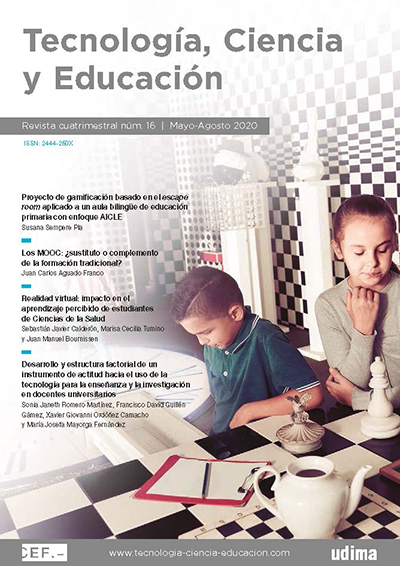Gamification project based on the escape room applied to a bilingual classroom of primary education with the CLIL approach
DOI:
https://doi.org/10.51302/tce.2020.437Keywords:
content and language integrated learning (CLIL), escape room, gamification, bilingual education, breakout boxAbstract
In the bilingual classrooms where content and language integrated learning (CLIL) is carried out, it is necessary to count on gamified environments since students will have to be highly motivated to learn content in a foreign language (english). Therefore, throughout this work a gamification project based on the escape room for a CLIL classroom will be developed. The escape room will contribute positively to CLIL, because it will offer a constructivist and playful methodology and it will make possible to deal with the «4 Cs» framework for CLIL effectively. The reason for this is that this technique of gamification and CLIL are compatible, as they have many similarities. The most appropriate term to refer to escape room in education is «breakout box», which is based on the resolution of different puzzles in a time limit to obtain the codes that will open the several locks of a breakout box. Thus, the designed project, aimed at 4th year of primary education and annual, will consist in the implementation of a breakout box at the end of each one of the units of Natural Sciences, which will be useful for increasing knowledge, promoting capabilities, and assessing in a motivating atmosphere. To ensure the understanding of the planning of an escape room in the CLIL classroom, one breakout box of the school year will be developed.
Downloads
References
Acedo, M. (2019). 10 specific ideas to gamify your classroom. TeachThought. Recuperado de http://teachthought.com/pedagogy/how-to-gamify-your-classroom/ (consultado el 3 de marzo de 2020).
Anderson, L., Krathwolh, D., Airasian, P., Cruikshank, K., Mayer, R., Pintrich, P., ... y Wittrock, M. (Eds.). (2014). A Taxonomy for Learning, Teaching, and Assessing: A Revision of Bloom’s. (2.ª ed.). Harlow, Inglaterra, Reino Unido: Pearson.
Center for Development of Human Services. (2015). The Child Development Guide. Recuperado de https://ocfs.ny.gov/main/fostercare/assets/ChildDevelGuide.pdf (consultado el 3 de marzo de 2020).
Cook, V. (2016). Second Language Learning and Language Teaching. (5.ª ed.). Nueva York, EE. UU.: Routledge.
Coyle, D. (2006). Content and language integrated learning: motivating learners and teachers. Scottish Languages Review, 13, 1-18.
Coyle, D. (2007). Content and language integrated learning: towards a connected research agenda for CLIL pedagogies. International Journal of Bilingual Education and Bilingualism, 10(5), 543-562.
Coyle, D., Hood, P. y Marsh, D. (2010). CLIL: Content and Language Integrated Learning. Cambridge, Inglaterra, Reino Unido: Cambridge University Press.
Dörnyei, Z. (2001). Motivational Strategies in the Language Classroom. Cambridge, Inglaterra, Reino Unido: Cambridge University Press.
Halbach, A. (2008). Una metodología para la enseñanza bilingüe en la etapa de primaria. Revista de Educación, 346, 455-466.
Jackson, C. (2016). How to Create a Low Cost Escape Room. Nevada: Moosehead Publishing.
Johnson, H. E. (2017). Breaking into Breakout Boxes: Escape Rooms in Education. Ciudad de Luxemburgo, Luxemburgo: Createspace Independent Pub.
Kapp, K. M. (2012). The Gamification of Learning and Instruction: Game-Based Methods and Strategies for Training and Education. San Francisco, California: Pfeiffer.
Krashen, S. (1982). Principles and Practice in Second Language Acquisition. Oxford, Inglaterra, Reino Unido: Pergamon.
Lasagabaster, D. y Sierra, J. M. (2010). Immersion and CLIL in english: more differences than similarities. ELT Journal, 64(4), 367-375. doi: https://doi.org/10.1093/elt/ccp082.
Leontaridi, E., Ruiz, M. y Peramos, N. (2008). Aprender no es un juego… ¿o sí?: el componente lúdico en la práctica de la destreza escrita en la clase de ELE. En J. F. Barrios (Coord.), Jornadas de Formación del Profesorado en la Enseñanza de L2/ ELE y la Literatura Española Contemporánea (pp. 153-164). Sofía, Bulgaria: San Clemente de Ojrid.
Ley orgánica 8/2013, de 9 de diciembre, para la mejora de la calidad educativa. (Boletín Oficial del Estado [BOE] 295, 10 de diciembre de 2013, pp. 97.858-97.921).
Marsh, D. (1994). Bilingual Education and Content and Language Integrated Learning. París, Francia: University of Sorbonne.
Marsh, D. (2000). Using languages to learn and learning to use languages: An introduction to CLIL for parents and young people. TIE-CLIL. Recuperado de http://archive.ecml.at/mtp2/clilmatrix/pdf/1UK.pdf (consultado el 3 de marzo de 2020).
Martín, A. M.ª, Paralela, C., Segovia, M.ª M. y Tenorio, Á. F. (2018). Evaluación y breakout. Anales de ASEPUMA, 26, 1-11.
Mehisto, P. (2012). Criteria for producing CLIL learning material. Encuentro, 21, 15-33.
Mehisto, P., Marsh, D. y Frigols, M. J. (2008). Uncovering CLIL: Content and Language Integrated Learning in Bilingual and Multilingual Education. Londres, Inglaterra, Reino Unido: Macmillan.
Nicholson, S. (2015). Peeking Behind the Locked Door: A Survey of Escape Room Facilities. Recuperado de http://scottnicholson.com/pubs/erfacwhite.pdf (consultado el 3 de marzo de 2020).
Noemi, K. (2008). Games in Teaching English as a Foreign Language: New Methods in Language Learning. Saarbrücken, Alemania: Verlag Dr. Müller.
Ormrod, J. E. (2005). Motivación y emoción. En J. L. Posadas (Ed.), Aprendizaje humano (pp. 479-509). Madrid, España: Pearson Educación.
Pajuelo, L. (2018). Escape room: la tendencia que arrasa en las aulas. Educación 3.0, 30, 16-17.
Pitarch, R. (2017). Gamifying content and language integrated learning with serious videogames. Journal of Language and Education, 3(3), 107-114. doi: https://doi.org/10.17323/2411-7390-2017-3-3-107-114
Real Decreto 126/2014, de 28 de febrero, por el que se establece el currículo básico de la educación primaria. (BOE 52, de 1 de marzo de 2014, pp. 19.349-19.420).
Rodríguez, F. y Santiago, R. (2015). Gamificación: cómo motivar a tu alumnado y mejorar el clima en el aula. Barcelona, España: Océano.
Ruiz-Velasco, E. (2007). Educatrónica: innovación en el aprendizaje de las ciencias y la tecnología. Madrid, España: Díaz de Santos.
Teixes, F. (2015). Gamificación: motivar jugando. Barcelona, España: Editorial OUC.
Walsh, A. (2017). Making Escape Rooms for Educational Purposes: A Wordbook. Huddersfield, Inglaterra, Reino Unido: Innovative Libraries.
Wright, A., Betteridge, D. y Buckby, M. (2006). Games for Language Learning. (3.ª ed.). Cambridge, Reino Unido: Cambridge University Press.
Downloads
Published
Versions
- 2021-11-25 (2)
- 2020-05-05 (1)
How to Cite
Issue
Section
License
Copyright (c) 2020 Susana Sempere Pla

This work is licensed under a Creative Commons Attribution-NonCommercial-NoDerivatives 4.0 International License.


























